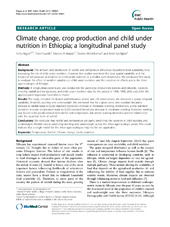| dc.contributor.author | Gebreyesus, Seifu Hagos | en_US |
| dc.contributor.author | Lunde, Torleif Markussen | en_US |
| dc.contributor.author | Mariam, Damen H. | en_US |
| dc.contributor.author | Woldehanna, Tassew | en_US |
| dc.contributor.author | Lindtjørn, Bernt | en_US |
| dc.date.accessioned | 2014-09-11T13:18:53Z | |
| dc.date.available | 2014-09-11T13:18:53Z | |
| dc.date.issued | 2014-08-27 | eng |
| dc.identifier.issn | 1471-2458 | |
| dc.identifier.uri | https://hdl.handle.net/1956/8453 | |
| dc.description.abstract | Background: The amount and distribution of rainfall and temperature influences household food availability, thus increasing the risk of child under nutrition. However, few studies examined the local spatial variability and the impact of temperature and rainfall on child under nutrition at a smaller scale (resolution). We conducted this study to evaluate the effect of weather variables on child under nutrition and the variations in effects across the three agro ecologies of Ethiopia. Methods: A longitudinal panel study was conducted. We used crop productions (cereals and oilseeds), livestock, monthly rainfall and temperature, and child under nutrition data for the period of 1996, 1998, 2000 and 2004. We applied panel regression fixed effects model. Results: The study included 43 clusters (administrative zones) and 145 observations. We observed a spatio temporal variability of rainfall, stunting and underweight. We estimated that for a given zone, one standard deviation increase in rainfall leads to 0.242 standard deviations increase in moderate stunting. Additionally, a one standard deviation increase temperature leads to 0.216 standard deviations decrease in moderate stunting. However, wasting was found to be poorly related with rainfall and temperature. But severe wasting showed a positive relationship with the quadratic term of rainfall. Conclusions: We conclude that rainfall and temperature are partly predicting the variation in child stunting and underweight. Models vary in predicting stunting and underweight across the three agro ecologic zones. This could indicate that a single model for the three agro ecologies may not be not applicable. | en_US |
| dc.language.iso | eng | eng |
| dc.publisher | BioMed Central | eng |
| dc.relation.ispartof | <a href="http://hdl.handle.net/1956/12864" target="_blank">Spatial variations in child undernutrition in Ethiopia: Implications for intervention strategies</a> | |
| dc.rights | Attribution CC BY | eng |
| dc.rights.uri | http://creativecommons.org/licenses/by/2.0 | eng |
| dc.subject | Temperature | eng |
| dc.subject | Rainfall | eng |
| dc.subject | Climate change | eng |
| dc.subject | Undernutrition | eng |
| dc.title | Climate change, crop production and child under nutrition in Ethiopia; a longitudinal panel study | en_US |
| dc.type | Peer reviewed | |
| dc.type | Journal article | |
| dc.date.updated | 2014-09-04T19:03:55Z | |
| dc.description.version | publishedVersion | en_US |
| dc.rights.holder | Copyright 2014 Hagos et al.; licensee BioMed Central Ltd. | |
| dc.rights.holder | Seifu Hagos et al.; licensee BioMed Central Ltd. | |
| dc.source.articlenumber | 884 | |
| dc.identifier.doi | https://doi.org/10.1186/1471-2458-14-884 | |
| dc.identifier.cristin | 1175369 | |
| dc.source.journal | BMC Public Health | |
| dc.source.40 | 14 | |

